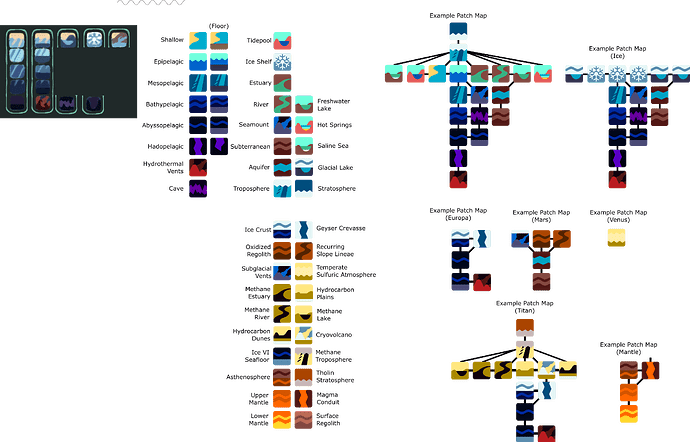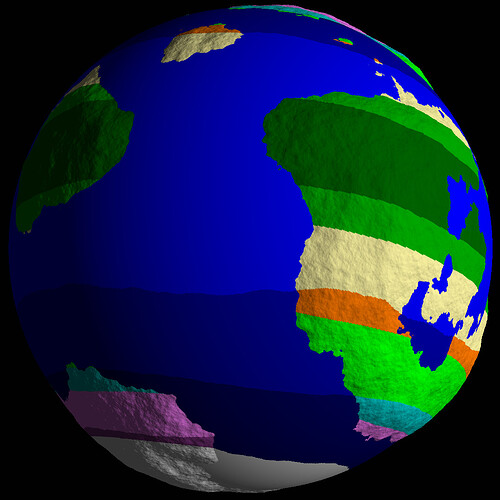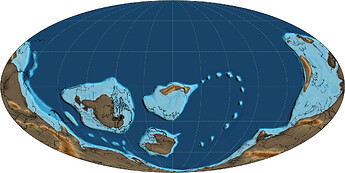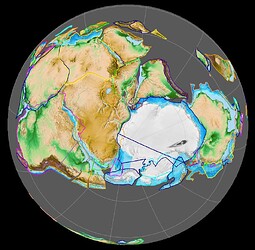Seems pretty good to me. Of course when someone actually gets to coding these features, we’ll discover a bunch of edge cases and parts that are surprisingly hard to program.
Here are some thoughts on how the patch map can change dynamically.
Dynamic Patch Maps
Involving some sort of dynamism with patches in the Microbe Stage will be pretty important to the setting of Thrive as millions and millions of years pass on. However, implementing complex simulations based on tectonic plates, and maps that are able to dramatically transform and look completely different isn’t necessary in the Microbe Stage; locations are so abstract that defined geographical features are very difficult and unnecessary to convey.
Therefore, I think dynamism in the patch map throughout the Microbe Stage can be represented adequately just through these features…
Potential for Surface Patches to Change - The depths are historically known for being relatively stable environments throughout most of Earth’s history. Most changes to the environment occur on the surface - shifts between estuaries and regular surface water, frozen patches, etc.
Ability for Connections Between Patch Clusters to Shift - Throughout time, the ability to go from one group of patches to another could shift. In other words, the lines between patches might disappear or reappear.
I think the second point is relatively self explanatory. One thing to note is that we would likely want to indicate when a patch is going to disappear. Making the lines dashed for a turn before could be a good way of representing this.
The first point requires some consideration. Realistically, there are four surface patches to consider: the epipelagic, coastal, estuary, and frozen patches. Shifts between the epipelagic and coastal environments won’t represent dramatic shifts from each other in the Microbe Stage. The real shift is the chance for glaciation, which will represent a considerable challenge for organisms and players existing on the patch.
One important question: how should we indicate that a patch is about to change? We probably don’t want to straight up just tell the player exactly what’s going to happen and what to do, but we should definitely make clear that the patch is going to change.
I think one simple way is to have a descriptor in the auto-evo reports tab in turns prior to the change. Along with changes in the graphs, a line of text which changes depending on the environment about to occur can be seen.
For example, a shift to polar seas can read: “Temperatures are getting colder and colder. The patch will change in X turns.” I’d say a 3 turn forewarning would be enough.
It makes logical sense for patch changes to be pretty limited based on the nature of the patch. By that, I mean that an epipelagic patch realistically won’t become an estuary. Here is the spread:
Epipelagic - Can become a shallow sea or a frozen patch. If becoming a shallow sea, cloud compound proportions all generally increase. If becoming frozen, temperatures drop and sunlight decreases.
Shallow Sea - Can become either of the other three. If becoming an estuary, becomes freshwater. If becoming epipelagic, compounds generally reduce and sunlight decreases. If becoming frozen, temperatures and sunlight drop.
Estuary - Can become a frozen patch or a shallow sea. If becoming a shallow sea, becomes saltwater. If becoming frozen, temperature and sunlight drop.
Frozen Sea - Can become any of the three. Temperature general increase and compounds grow to reflect other patches.
These can generally be expressed as chance, though if temperatures are low, the chances of becoming frozen can increase. Environmental events can dramatically alter local conditions; shifts outside of environmental events aren’t very likely.
I think the relative simplicity of patch shifts in the Microbe Stage will serve as a really good and simple introduction to the challenges one will face in the later stages, where patches will be more explicitly defined.
Environmental Events
Here is a write up on environmental events. A lot of this is existing concepts written up to be more actionable.
Volcanic Eruption - Affected regions experience initial warming, and later some temporary cooling. Sunlight is significantly reduced. Sulfur becomes much more common, along with phosphate and ammonia. Can last anywhere from 3-5 turns.
Meteor Strike - Very similar to volcano, but more short-lived. Affected regions experience initial warming, and then a less severe cooling. Sunlight is reduced. Effects can last 1-2 turns.
Glaciation - General climate trend. Some surface patches become icy seas, and temperatures get somewhat cooler globally. Some variance, but shouldn’t necessitate significant adaptations in all patches. Depths shouldn’t be significantly affected.
Global Warming - General climate trend. Icy seas reduce in frequency, and global temperatures generally increase. Some variance, perhaps enough for icy seas to completely disappear, but shouldn’t necessitate significant adaptations in all patches. Depths shouldn’t be significantly affected.
Snowball Earth - Glaciation which all of almost all surface patches on Earth freeze over, and most mesopelagic patches get colder. Some variance, but can last anywhere from 3 to 6 turns. Depths shouldn’t be significantly affected.
(Bonus) Earthquake - I don’t think this one is necessary, but the concept existed for a while. Currents on a patch change completely during gameplay.
EDIT: I’d like to note that if it is too much of a headache, I think attaching patch changes to environmental events only is adequate. This would exclude changes between estuaries , epipelagic, and shallow seas, but glaciation and global warming are the two most common and significant environmental changes throughout history.
I like these concepts, however something to keep in mind is turn length. Each “turn” (player generation) represents 100 million years. If a Volcanic Eruption is an event lasting 3-5 turns, that’d be 300-500 million years.
To my knowledge, the longest volcanic event in Earth’s history was the eruption of the Siberian Traps, which spanned roughly 2 million years and was the primary cause of the Permian-Triassic extinction.
I don’t believe there’s a real solution to this. Turns could perhaps be reduced to 50 million years, but any shorter and the player would become eukaryotic and multicellular on vastly shorter timescales than we know to have happened on Earth.
I think that there should be two kinds of events: in-gameplay events, like the Earthquake you mentioned, that briefly change gameplay in a patch, and events that affect large areas of the planet on timescales of tens or hundreds of millions of years, such as Glaciation/Snowball Earth.
That is a good point, though like you mentioned I wouldn’t really know a solution that makes sense besides perhaps treating environmental events differently when it comes to keeping track of time. Even the longest Snowball Earth event in Earth’s history would essentially be one Microbial generation. It might just have to be another point to concede in that old Thrive inaccuracies thread we have here - the fact that thrivian environmental events last much longer than real ones do.
Some possible ideas: Increase the patches available in the world. This would allow for differences around a land mass which could also help in the efforts towards the planet generator since the patches and landmasses generated would be tied very close to one another.
Variations in the patches that currently don’t have a cold or hot or neutral temperature variant (for glaciation and hot house environmental events). The tide pool is one such location that would need variants to make it work with environmental events.
Patches being able to vanish or appear based on tectonic activity since such things occur. (adding patches would be like the forming of the Atlantic as Africa and South America split apart and removing patches would be like India slamming into Asia)
Also Global Warming should be Hot House as Global Warming/Climate Change is used regarding human activities changing the environment at an unnatural pace. Hot House is the termed generally used for Earth’s hotter periods
Extra Patch concept that Aaronmkersh uploaded on the Podcast discord chat that I thought I’d post here as well
Thanks for posting these, it slipped my mind to put them here. I’ll briefly elaborate on what’s shown here:
First are extra patch types that microbes live in on Earth. The Seamount is an underwater volcano. According to various observations microbes can live in the Troposphere and Stratosphere layers of Earth’s atmosphere, though to my understanding there is not consensus on if, or how many, microbe species truly thrive and reproduce up there or if they are merely carried by the wind currents. Microbes are also known to exist as much as 3 km under the ground, represented by the Subterranean and Aquifer patches.
Second are patches representing ice shell worlds with subsurface oceans like Europa, with hydrothermal vents and geysers / cryovolcanoes that sometimes blast water into space. It is possible life exists on worlds like these, and there are tentative hints in support of it, but ultimately it remains unknown. Certainly, it is theoretically possible.
Third are patches where microbes may be found on Mars. Like with Europa, there remains the potential for life but no confirmation as of yet. Recurring Slope Lineae are places where water seasonally leaches out through sides of craters, canyons and other features, creating small streams visible on the surface. Oxidized Regolith is the soil of mars, which the Viking missions in the 1970s may or may not have detected signs of microbial life in with their experiments. Again, inconclusive, but life is theoretically possible. It is worth noting that we believe Mars once had a water cycle and oceans, where life could have arose, and which were eventually lost. Mars also has an ice cap on its south pole, under which may reside liquid water kept warm by geothermal activity, represented by the Subglacial Vents.
Fourth is a single patch for Venus, representing the temperate layer in its upper atmosphere, which is actually the most Earth-like location (in terms of pressure and temperature) in the entire solar system. The main exception is the high amount of sulfuric acid, but there are theoretical ways life could endure such conditions, and many tentative hints that microbial life may indeed exist in its upper atmosphere. Again, though, not confirmed, but theoretically possible.
Fifth are patches representing various locations on Titan, which is utterly fascinating in its diversity and strangeness, and its potential for exotic, non-carbon-and-water-based life. It has methane and ethane rivers, lakes and rain, tons of surface variation, and all that on top of a likely subsurface water ocean. There’s far too much to get into here, and it really is fascinating, so I recommend just taking a look at the Wikipedia page for Titan, and other resources.
Sixth and finally are mantle patches, representing the environment for HIGHLY theoretical silicon dioxide (lava) based life. If life exists in these environments, it would be like nothing we have ever known.
This Wikipedia article broadly covers alternative biochemistries, including liquid hydrocarbon based life which may exist on Titan, silicon dioxide based life, and many others:
I will note that I do not think excessively theoretical biochemistries such as silicon dioxide should be included in the main scope of Thrive, but they are prime real estate for modding, and I plan on trying my hand at some of these eventually.
I have already stated that I would like to see more patches in the game. Particularly new patch types that allow players and auto-evo to evolve more unique and environment specific microbes. In general, I would like to see patches that represent environments with unique advantages and challenges.
Examples of some interesting patches would be:
- Hot springs, which would allow photosynthesis, chemosynthesis and thermosynthesis in the same patch. This would also enable possible sulphur photosynthesis which I believe was suggested a couple of times.
- Lakes and Rivers, particularly once Environment Tolerances are implemented. The interesting aspect of these patches would be the difference between sweet and salt water as well as having to deal with strong currents in rivers.
What do I propose?
However, I think other than having compounds and gasses in the environment change both over time and between patches, more specific “traits” should be used for certain patches or even entire regions.
For example, a certain patch might have a trait called “toxic chemicals”. This patch would have a vastly increased amount of environmental toxins. The player would see this trait on the patch map when selecting the patch, probably as an icon somewhere on the UI. If the player wanted to move to or through that patch, they would have to adapt to the new conditions. In this case it would be simple: increase health.
Alternatively, traits could be applied to entire regions. A trait like “trace ammonia” would mean greatly reduced quantities of ammonia in the patches of the region. This could serve as an incentive to evolve nitrogen fixing organelles which don’t see much use currently.
Other interesting traits might be:
- “Frozen Waters” - reduces amount of lux and causes ice chunks to spawn (this could affect entire regions)
- “High Geothermal Activity” - causes hydrogen sulfide to spawn (this would apply to patches other than vents, or entire regions)
- “High mucilage concentrations” - causes mucilage to spawn naturally (this would only appear once there are enough microbes in a patch)
- “High glucose concentrations” - causes a lot of natural glucose to spawn in the patch
Why should this be implemented?
I believe this system of patch/region traits would serve both as challenges and opportunities for players. This would make every planet and every game unique, with different opportunities for evolution and different challenges to face. It would be a way for the environment to affect the life on the planet, even before actual planet generation.
Moreover, I think this is more than just a “quick fix” before the planet generator. Actually, I think it would work well in tandem with a more advanced planet generator to represent local environments, or more broadly continents or regions. The planet generator would determine which traits could be generated.
I think it’s a clear system, that players understand. It is not too complicated to follow, and I have seen similar systems in other games. It is probably also easy to generate without getting into the nitty gritty of planet generation.
Getting back to development and reading through this now.
I still think adding entirely new patches isn’t too much of a solution right now since I think the primary problem when it comes to patches is differentiated gameplay; adding more patches right now I think would essentially be adding different backgrounds.
But your “trait/feature” proposal sounds pretty cool, where unique features might randomly occur in specific patches. That can offer some good variety in gameplay, and can result in more unique patches. It could also be how we handle environmental events, such as anoxygenation events, nutrient influxes, etc. that could be something to investigate when we get to the patch/environment revamps.
Have we come to a consensus on how finely we want the oceans to be partitioned? The closest to the current patch map generator would probably be to classify the oceans into two bands: Ice Cap and Ocean. (Ice Cap would provide the Ice shelf patches on its boundary) There doesn’t seem to be much variation between different ocean temperatures right now in the current patch map generator, so only one non-frozen ocean classification would be sufficient to emulate the current behavior. But do we want to just emulate the current patch map generator behavior, or do we want a different classification method? Splitting the ocean types into, say, tropical and temperate for example.
These (unfortunately low resolution) NASA maps are a comparison of how the temperature changes on Earth. The right image shows that adding more temperature bands only really differentiates the surface of the oceans.
Also, right now the patch map is fully connected. How do we want to deal with disconnected sections, which would likely be only a few ocean patches at most consisting of an interior ocean or large lakes inside of a supercontinent or continent cluster? Are disconnected regions just not shown on the Microbe/Multicellular stage patch map if they are not accessible?
Furthermore, is the patch map supposed to represent the entire world at the highest level, or is it just a representative subsection of the world? Increasing the fineness of ocean partitioning will also increase the amount of patches we have, so if we need to limit the number of patches created then the patch map will have to be a subset of some sort. The world size setting could then adjust how much of the world subsection is selected in for the patch map used in Microbe/Multicellular.
I imagine that this will have to be adjusted quite a bit until we find the ideal solution, but it would be useful to have an ideal to point towards until then.
Excellent discussion to bring up. I’ll start here:
I personally interpret it as a very abstract representation of the entire world, with that abstraction being the most meaningful way to represent the world to a Microbe. After a certain point, granularity wouldn’t make too much sense in the Microbe Stage for two reasons: it’s a 2D playing space with no meaningful geography, and microbes are just too small for that sort of information to really matter beyond a general characteristic of the environment.
There are concepts of events which temporarily block movement outside of a patch cluster in the past which would kind of have represented geographical isolation. That hasn’t been implemented so far, so we are kind of in a state where there’s an awkward in-between.
I think the best way to think of it right now is that, since the time jump between a generation is so big currently, it’s just inevitable that somehow, movement can look pretty free-form. So currently, geographic isolation isn’t represented, but that could change (as in, if a volunteer implemented it, I would definitely find it valuable).
Not quite, but I do think the two most important factors for ocean partitioning would be depth and temperature - and also, the possibility for a “special characteristic” of sorts if that makes sense?
So the most basic classification system would be Frozen, Cold, Temperate, and Tropical in terms of temperature. Then, depending on depth, Continental Shelf/Shallow Seas, Epipelagic, Mesopelagic, Bathypelagic, Abyssopelagic, then the Ocean Floor. Like you mention, ocean temperature generally varies the most on the surface, so sub-surface patches won’t generally be too affected by temperature classifications.
By those “special characteristics” I mentioned above - there might be specific features, like coral reefs, abysses/trenches, potentially vents, and intertidal zones that we would want to represent. So a way to tell the patch map “this specific patch is unique because it has this” would be useful.
I’m interested to see your opinion on implementing features like wetlands - estuaries, swamps, and intertidal zones particularly. That’s normally a level of detail that I would think is too granular, but these specific environments are really important for life’s story, as it’s where animals prepare to transition to land.
If you have any further questions or want further clarification, do let me know. This is an important feature, so I want to make sure you have designs and concepts readily accessible to make sure your development is unimpeded.
Those also seem important, but I think they will have to be handled differently due to how small these features are. Distinguishing these features is not very possible at the grandest scales where the entire world is able to be partitioned at, so they would need to be added in like those “special characteristics” you mention. It shouldn’t be too difficult to add these features onto the patch map generated from partitioning the grand scale of the 3D world for use in the Microbe/Multicellular stages, but it might be harder to have those features be accurate in the later stages when the 3D world is zoomed into.
Perhaps the continuity between the Microbe/Multicellular map and the later stage’s world does not need to be too accurate, as the world would be expected to change significantly anyway. Earth’s continents and oceans certainly seem to have little similarity in that era of Earth’s history. For example, Earth at the time of the Cambrian Explosion looks completely different:
Perhaps you could even take the 2D patch map generated with the current system and randomly assign the patches to the 3D world’s patches, and it would still be accurate enough to reality due to tectonic drift randomizing things.
Yeah, I’d say do not be too worried about having any sort of strict continuity between the world of the microscopic and the world of the macroscopic. Abstraction and everything is a factor, but beyond that, the world can change pretty rapidly in appearance, even within a time frame of a few million years.





